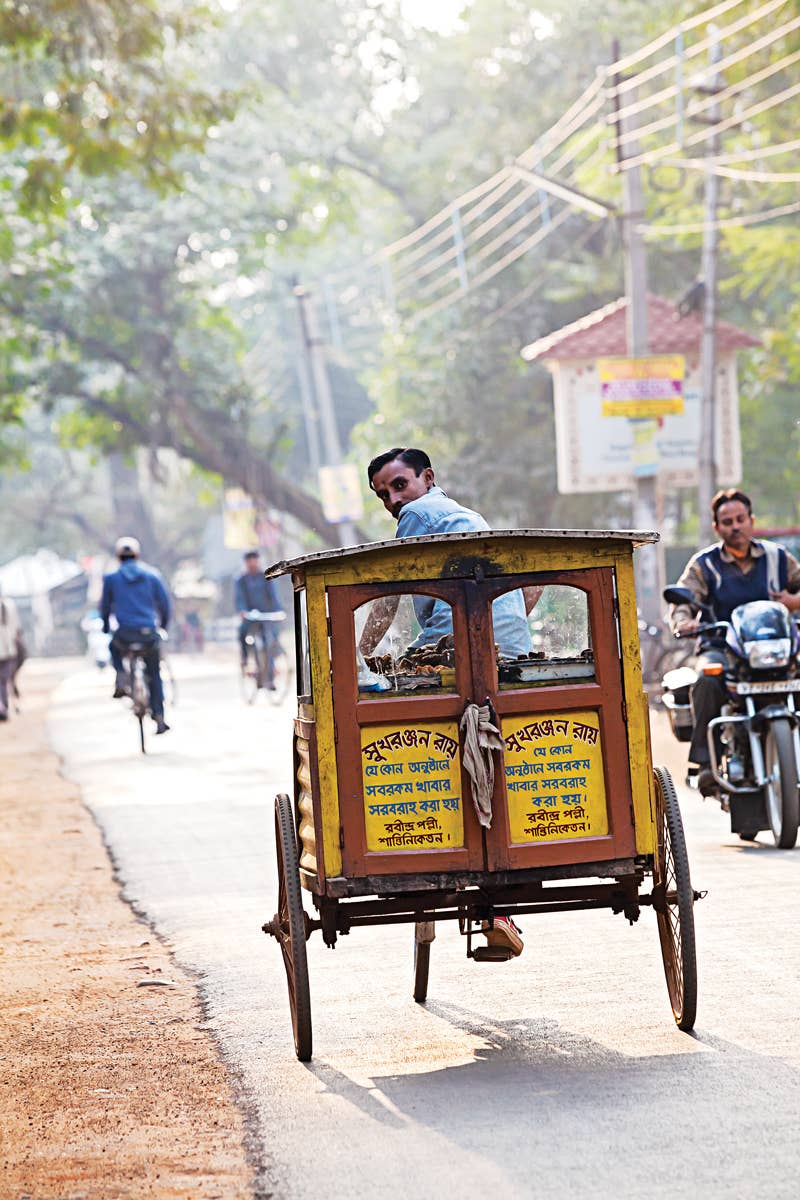
At 4:30 p.m. in the Bengal village of Santiniketan, evening cooking fires belch smoke from kitchen windows. I pull my shawl a little tighter around my shoulders, waiting for the mishti garri—the "sweets car"—beside a row of small cement-walled houses in the narrow cul de sac near my family home.
Since I was a little girl, my grandmother has purchased the Bengali sweets known as mishti from Sukharanjan Roy. Referred to by all in the village as Sukharanjan-da—elder brother Sukharanjan—he was a distinctive sight, tooling around this quiet town on his bicycle with a glass-encased dessert cart in tow. Hearing him coming down the street, housewives would run to their front gates, steel tiffin carriers in hand for him to fill with gooey treats.
While every region of the subcontinent has its own sweets culture, no Indian state is as thoroughly dessert obsessed as Bengal. The northeastern region is renowned for its exquisite date-palm sugar, nolen gur, and visitors are always greeted with a cup of sweet tea and a metal saucer holding a mishti or two. Bengalis particularly adore creamy milk-based sweets, which are eaten at the end of a meal or even for breakfast, scooped up with the whole-wheat flatbread chapati. Sukharanjan-da's piled-high trays reflect this predilection for dairy, with sweets made of creamy curd from local cow's milk: fudgy shondesh, sweetened with date palm sugar; malai chom chom, smooth, white logs of curd bathed in sweet cream; and spongy, white rosogullas that squeak between my teeth. His kalo jam, dough made from semolina flour and milk, is fried until dark brown and dunked in sweet syrup.
For Sukharanjan-da, who is now 62 and a grandfather, mishti was more than a calling; it was a means of survival. Although I have known him for years, I only found out his story on a recent visit. He arrived in Santiniketan in 1968 as a teenager, with his mother and brother, as a bloody war was brewing in his homeland, the land that would become Bangladesh. With a family to help support, the young Sukharanjan-da needed a source of steady income. He had picked up mishti-making skills at a canteen back home and decided to throw in his lot with the town's street vendors. Others hawked their snacks from wooden carts, but Sukharanjan-da decided his conveyance should stand out. So he secured a bank loan of 800 rupees ($13) and handed it over to a metal fabricator, along with a design he drew by hand for a rolling case that would offer customers a tantalizing glimpse of his luscious sweets.
The mishti garri was no get-rich-quick plan, but it earned Sukharanjan-da a decent living—enough to send his children to school and to build a brick house at the outskirts of town. His 28-year-old son, Pintu, followed in his footsteps, and now does most of the mishti-making and the daily rounds in the mishti garri, just as his father did for three decades.
On this day it was Pintu I hoped to see pedaling by as I waited on his daily route, but as the sky began to turn pink, I worried that I had missed him. I wheeled my bike deeper into the neighborhood and found a woman in a housecoat taking laundry from a line in her garden.
"Mishti garri khotay?" I asked, desperation creeping into my voice. Where is the sweets car?
"Sukharanjan-da chele," she replied with a nod, referring to Pintu as he is probably doomed to be always known—Sukharanjan-da's son.
She pointed down a side street, and from a distance I heard the rhythmic honk of an old-fashioned bike horn and Pintu's droning call of the mishti-wallah cataloging the day's sweets: "shondesh, chom chom, ladoo, lobongo latika... " I jumped back on my bike and manically pedaled until I finally glimpsed the yellow-painted aluminum mishti garri.
He didn't need to ask me what I'd like to take home to my family. He scooped a dozen pantua—teeth-achingly sweet cottage-cheese-based sweets, deep-fried and then soaked in syrup. He wrapped a dozen peraki—crunchy fried turnovers stuffed with oozing date-palm sugar—in pages from a Bengali newspaper, tied the package up with string, and carefully placed it in my bicycle basket.
Then, with the charm he learned from his father, Pintu handed me a still-warm pantua to sample. I devoured it, syrup dripping down my fingers, as I watched the sun set.
Keep Reading
Continue to Next Story










